| Listing 1 - 10 of 37 | << page >> |
Sort by
|
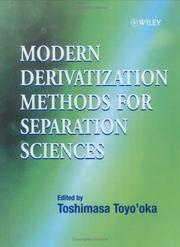
ISBN: 0471983640 Year: 1999 Publisher: New York (N.Y.) : Wiley,
Abstract | Keywords | Export | Availability | Bookmark
 Loading...
Loading...Choose an application
- Reference Manager
- EndNote
- RefWorks (Direct export to RefWorks)
Chromatographic analysis --- Derivatization. --- Methodology.
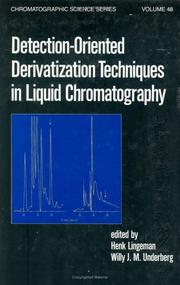
ISBN: 0824782879 Year: 1990 Volume: 48 Publisher: New York : M. Dekker,
Abstract | Keywords | Export | Availability | Bookmark
 Loading...
Loading...Choose an application
- Reference Manager
- EndNote
- RefWorks (Direct export to RefWorks)
Derivatization --- Liquid chromatography --- Chromatographie en phase liquide --- Derivatization. --- Liquid chromatography.
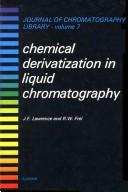
ISBN: 0444414290 9786611772208 1281772208 0080858074 9780080858074 9780444414298 9781281772206 6611772200 Year: 1976 Volume: v. 7 Publisher: Amsterdam Elsevier
Abstract | Keywords | Export | Availability | Bookmark
 Loading...
Loading...Choose an application
- Reference Manager
- EndNote
- RefWorks (Direct export to RefWorks)
Chemical Derivatization in Liquid Chromatography
Chromatography, Liquid --- Liquid chromatography --- Chromatographie en phase liquide --- methods --- 543.544 --- Derivatization --- Liquid-liquid partition chromatography --- Chromatographic analysis --- Chemical reactions --- methods. --- Chromatographic analysis. Chromatography --- Derivatization. --- Liquid chromatography. --- Methods. --- 543.544 Chromatographic analysis. Chromatography
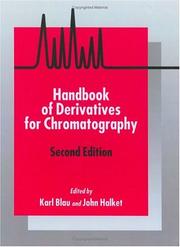
Abstract | Keywords | Export | Availability | Bookmark
 Loading...
Loading...Choose an application
- Reference Manager
- EndNote
- RefWorks (Direct export to RefWorks)
543.544 --- Chromatographic analysis --- -Derivatization --- -#ABIB:vcbt --- 543.544 Chromatographic analysis. Chromatography --- Chromatographic analysis. Chromatography --- Chemical reactions --- Analysis, Chromatographic --- Chromatography --- Chemistry, Analytic --- Phase partition --- Handbooks, manuals, etc --- Derivatization --- #ABIB:vcbt --- Fysicochemical separation methods --- Handbooks, manuals, etc. --- Chromatographie --- Guides, manuels, etc --- Analytical chemistry
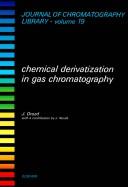
ISBN: 0444419179 9780444419170 9780080858203 0080858201 9786611777937 1281777935 Year: 1981 Volume: 19 Publisher: Amsterdam : New York : Elsevier Scientific ; Distributors for the U.S. and Canada, Elsevier/North-Holland,
Abstract | Keywords | Export | Availability | Bookmark
 Loading...
Loading...Choose an application
- Reference Manager
- EndNote
- RefWorks (Direct export to RefWorks)
Chemical Derivatization in Gas Chromatography
Fysicochemical separation methods --- Gas chromatography --- Chromatographie en phase gazeuse --- Derivatization. --- Gas chromatography. --- Chromatographic analysis. --- Gas-liquid chromatography --- GLC (Chromatographic analysis) --- Vapor-phase chromatography --- Chromatographic analysis --- Analysis, Chromatographic --- Chromatography --- Analytical chemistry --- Phase partition
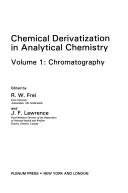
ISBN: 0306409666 030640608X 1461591961 1461591945 146844204X 1468442023 Year: 1981 Publisher: New York, NY : Plenum Press,
Abstract | Keywords | Export | Availability | Bookmark
 Loading...
Loading...Choose an application
- Reference Manager
- EndNote
- RefWorks (Direct export to RefWorks)
543.2 --- Special chemical methods of analysis --- Derivatization. --- Gas chromatography. --- 543.2 Special chemical methods of analysis --- Liquid chromatography. --- Chimie analytique --- Additifs alimentaires --- Derivatisation --- Enzymes --- Paires d'ions --- Pesticides --- Spectrometrie de masse
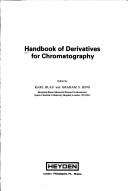
ISBN: 0855012064 9780855012069 Year: 1978 Publisher: London Heyden
Abstract | Keywords | Export | Availability | Bookmark
 Loading...
Loading...Choose an application
- Reference Manager
- EndNote
- RefWorks (Direct export to RefWorks)
Chromatographic analysis --- Chromatographie --- Handbooks, manuals, etc --- Guides, manuels, etc --- Derivatization --- Chemistry Techniques, Analytical. --- Chromatography. --- Chromatographies --- Analytical Chemistry Methods --- Analytical Chemistry Techniques --- Analytical Chemistry Method --- Analytical Chemistry Technique --- Chemistry Method, Analytical --- Chemistry Methods, Analytical --- Chemistry Technique, Analytical --- Method, Analytical Chemistry --- Methods, Analytical Chemistry --- Technique, Analytical Chemistry --- Techniques, Analytical Chemistry --- CHEMISTRY --- CHROMATOGRAPHY --- Handbooks, manuals, etc. --- ANALYTICAL --- handbooks --- handbooks. --- Chemistry --- Chromatography --- Analytical --- Handbooks. --- Fysicochemical separation methods --- Chemistry Techniques, Analytical --- Chemical reactions --- Analysis, Chromatographic --- Chemistry, Analytic --- Phase partition --- Analytical, handbooks. --- Analytical chemistry --- Chromatographic analysis - Handbooks, manuals, etc. --- Derivatization - Handbooks, manuals, etc.
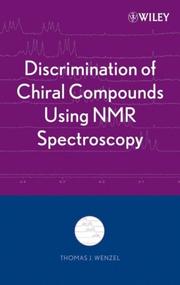
ISBN: 9780471763529 0471763527 Year: 2007 Publisher: Hoboken Wiley
Abstract | Keywords | Export | Availability | Bookmark
 Loading...
Loading...Choose an application
- Reference Manager
- EndNote
- RefWorks (Direct export to RefWorks)
Chemical tests and reagents. --- Nuclear magnetic resonance spectroscopy. --- Chirality. --- Chimie --- Spectroscopie de la résonance magnétique nucléaire --- Chiralité --- Essais et réactifs --- Enantiomers --- 544.176 --- 544.122.3 --- Derivatization. --- Chemical reactions --- Stereochemistry --- Symmetry (Physics) --- Antipodes, Optical --- Enantiomorphs --- Isomers, Mirror-image --- Mirror-image isomers --- Optical antipodes --- Optical isomers --- Chirality --- NMR spectroscopy --- Spectroscopy, NMR --- Spectroscopy, Nuclear magnetic resonance --- Nuclear spectroscopy --- Knight shift --- Chemical reagents --- Reagents, Chemical --- Indicators and test-papers --- Derivatives. --- Nuclear magnetic resonance spectra. Nuclear Overhauser effect spectra --- Spectroscopie de la résonance magnétique nucléaire --- Chiralité --- Essais et réactifs --- Chemical tests and reagents --- Derivatization --- Nuclear magnetic resonance spectroscopy --- Derivatives
Book
Year: 2022 Publisher: Basel MDPI - Multidisciplinary Digital Publishing Institute
Abstract | Keywords | Export | Availability | Bookmark
 Loading...
Loading...Choose an application
- Reference Manager
- EndNote
- RefWorks (Direct export to RefWorks)
In recent years, there has been rapid growth in the availability of innovative, non-combustible products, including oral tobacco-derived nicotine (OTDN) products, heated tobacco products (HTPs), and electronic cigarettes (also referred to as e-vapor products; EVPs). Industry, academic, and government researchers are developing and validating analytical methods to extract, separate, identify, and quantitate a variety of analytes from these innovative tobacco products using a wide range of analytical techniques. These analytes include constituents such as nicotine, degradants and impurities, flavors, non-tobacco ingredients, HPHCs, and other currently unknown constituents. In this Special Issue, we received nine contributions that covered the latest analytical methods that have been developed and applied for the chemical characterization or exposure assessment to tobacco product constituents of innovative non-combustible products. This Special Issue is representative of the importance of analytical sciences research in characterizing innovative non-combustible products for guiding product design, determining relative product performance, ensuring consistency during the manufacturing process, informing toxicological risk assessment, and enabling regulatory reporting. The current advances in the development and applications of the analytical methods reported in this Special Issue can be used to inform the harm reduction potential of innovative non-combustible products for adult smokers.
Research & information: general --- Chemistry --- Analytical chemistry --- on!® nicotine pouches --- nicotine --- dissolution --- release profile --- validation --- product assessment --- smokeless tobacco product --- nicotine degradants --- nicotine-related impurities --- alkaloids --- nicotine degradation products --- nicotine pouches --- reduced-risk products --- constituents --- method development --- method validation --- JUUL --- aerosol --- non-targeted analysis --- chemical characterization --- ENDS --- e-cigarette --- GC-MS --- LC-HRMS --- e-liquid --- 2,4-DNPH derivatization --- formaldehyde --- "hidden formaldehyde" --- formaldehyde-containing hemiacetal/acetal adducts --- HPHC --- GC-MS --- 3-hydroxybenzo[a]pyrene --- LC-MS/MS --- urine --- human biomonitoring --- derivatization --- potentially reduced-risk products --- propylene glycol --- electronic cigarette --- biomarker of exposure --- compliance marker --- oral tobacco derived nicotine (OTDN) pouches --- snus --- nicotine release --- nicotine dissolution --- nicotine extraction --- equivalence --- modern oral nicotine products --- HPHCs --- product characterizations --- on!® nicotine pouches --- nicotine --- dissolution --- release profile --- validation --- product assessment --- smokeless tobacco product --- nicotine degradants --- nicotine-related impurities --- alkaloids --- nicotine degradation products --- nicotine pouches --- reduced-risk products --- constituents --- method development --- method validation --- JUUL --- aerosol --- non-targeted analysis --- chemical characterization --- ENDS --- e-cigarette --- GC-MS --- LC-HRMS --- e-liquid --- 2,4-DNPH derivatization --- formaldehyde --- "hidden formaldehyde" --- formaldehyde-containing hemiacetal/acetal adducts --- HPHC --- GC-MS --- 3-hydroxybenzo[a]pyrene --- LC-MS/MS --- urine --- human biomonitoring --- derivatization --- potentially reduced-risk products --- propylene glycol --- electronic cigarette --- biomarker of exposure --- compliance marker --- oral tobacco derived nicotine (OTDN) pouches --- snus --- nicotine release --- nicotine dissolution --- nicotine extraction --- equivalence --- modern oral nicotine products --- HPHCs --- product characterizations
Book
Year: 2022 Publisher: Basel MDPI - Multidisciplinary Digital Publishing Institute
Abstract | Keywords | Export | Availability | Bookmark
 Loading...
Loading...Choose an application
- Reference Manager
- EndNote
- RefWorks (Direct export to RefWorks)
In recent years, there has been rapid growth in the availability of innovative, non-combustible products, including oral tobacco-derived nicotine (OTDN) products, heated tobacco products (HTPs), and electronic cigarettes (also referred to as e-vapor products; EVPs). Industry, academic, and government researchers are developing and validating analytical methods to extract, separate, identify, and quantitate a variety of analytes from these innovative tobacco products using a wide range of analytical techniques. These analytes include constituents such as nicotine, degradants and impurities, flavors, non-tobacco ingredients, HPHCs, and other currently unknown constituents. In this Special Issue, we received nine contributions that covered the latest analytical methods that have been developed and applied for the chemical characterization or exposure assessment to tobacco product constituents of innovative non-combustible products. This Special Issue is representative of the importance of analytical sciences research in characterizing innovative non-combustible products for guiding product design, determining relative product performance, ensuring consistency during the manufacturing process, informing toxicological risk assessment, and enabling regulatory reporting. The current advances in the development and applications of the analytical methods reported in this Special Issue can be used to inform the harm reduction potential of innovative non-combustible products for adult smokers.
Research & information: general --- Chemistry --- Analytical chemistry --- on!® nicotine pouches --- nicotine --- dissolution --- release profile --- validation --- product assessment --- smokeless tobacco product --- nicotine degradants --- nicotine-related impurities --- alkaloids --- nicotine degradation products --- nicotine pouches --- reduced-risk products --- constituents --- method development --- method validation --- JUUL --- aerosol --- non-targeted analysis --- chemical characterization --- ENDS --- e-cigarette --- GC–MS --- LC–HRMS --- e-liquid --- 2,4-DNPH derivatization --- formaldehyde --- “hidden formaldehyde” --- formaldehyde-containing hemiacetal/acetal adducts --- HPHC --- GC-MS --- 3-hydroxybenzo[a]pyrene --- LC–MS/MS --- urine --- human biomonitoring --- derivatization --- potentially reduced-risk products --- propylene glycol --- electronic cigarette --- biomarker of exposure --- compliance marker --- oral tobacco derived nicotine (OTDN) pouches --- snus --- nicotine release --- nicotine dissolution --- nicotine extraction --- equivalence --- modern oral nicotine products --- HPHCs --- product characterizations --- n/a --- LC-HRMS --- "hidden formaldehyde" --- LC-MS/MS
| Listing 1 - 10 of 37 | << page >> |
Sort by
|

 Search
Search Feedback
Feedback About UniCat
About UniCat  Help
Help News
News